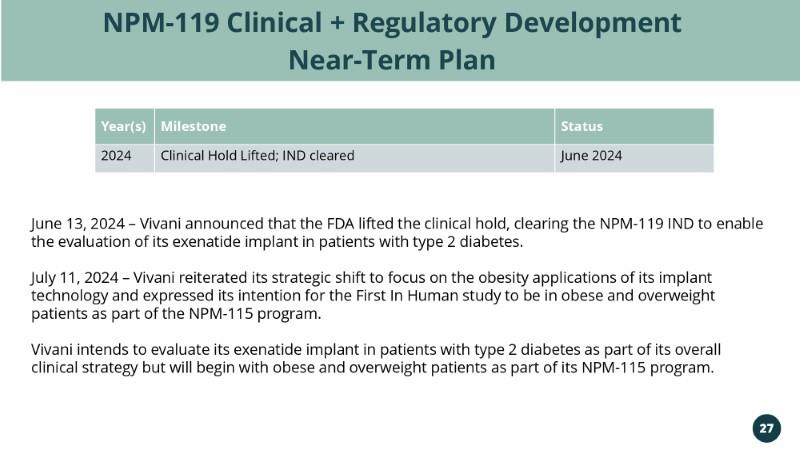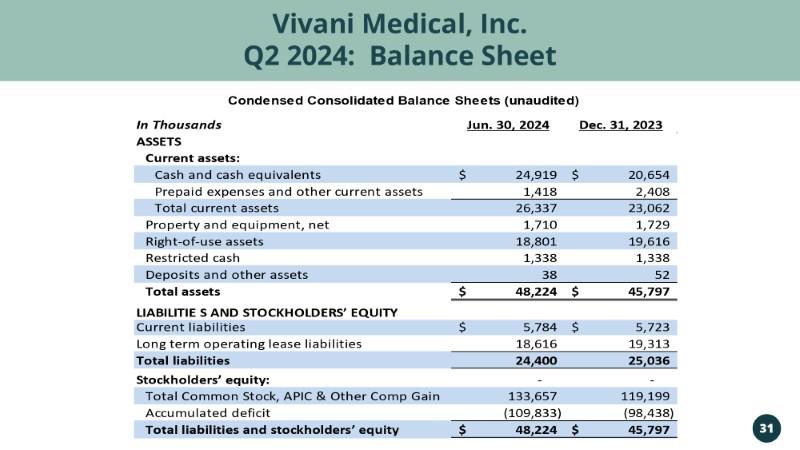
www.vivani.com Vivani Medical, Inc. Guaranteed Adherence. Adherence Adherence. August 2024
.
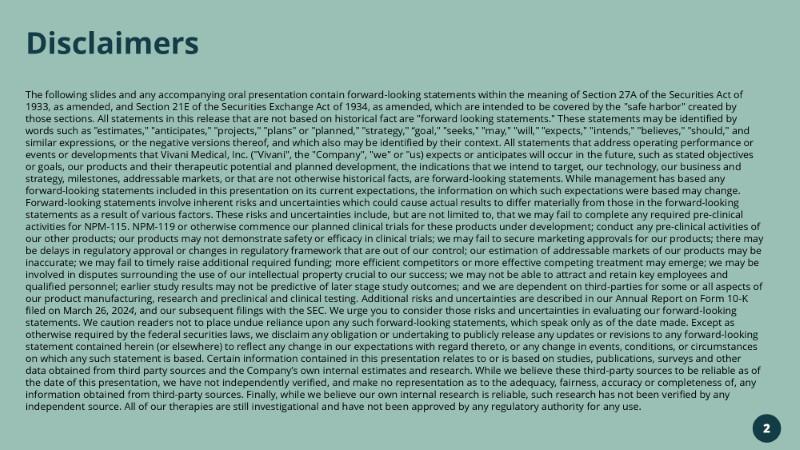
Disclaimers The following slides and any accompanying oral presentation contain forward-looking statements within the meaning of Section 27A of the Securities Act of 1933, as amended, and Section 21E of the Securities Exchange Act of 1934, as amended, which are intended to be covered by the "safe harbor" created by those sections. All statements in this release that are not based on historical fact are "forward looking statements." These statements may be identified by words such as "estimates," "anticipates," "projects," "plans" or "planned," "strategy," “goal," "seeks," "may," "will," "expects," "intends," "believes," "should," and similar expressions, or the negative versions thereof, and which also may be identified by their context. All statements that address operating performance or events or developments that Vivani Medical, Inc. ("Vivani", the "Company", "we" or "us) expects or anticipates will occur in the future, such as stated objectives or goals, our products and their therapeutic potential and planned development, the indications that we intend to target, our technology, our business and strategy, milestones, addressable markets, or that are not otherwise historical facts, are forward-looking statements. While management has based any forward-looking statements included in this presentation on its current expectations, the information on which such expectations were based may change. Forward-looking statements involve inherent risks and uncertainties which could cause actual results to differ materially from those in the forward-looking statements as a result of various factors. These risks and uncertainties include, but are not limited to, that we may fail to complete any required pre-clinical activities for NPM-115. NPM-119 or otherwise commence our planned clinical trials for these products under development; conduct any pre-clinical activities of our other products; our products may not demonstrate safety or efficacy in clinical trials; we may fail to secure marketing approvals for our products; there may be delays in regulatory approval or changes in regulatory framework that are out of our control; our estimation of addressable markets of our products may be inaccurate; we may fail to timely raise additional required funding; more efficient competitors or more effective competing treatment may emerge; we may be involved in disputes surrounding the use of our intellectual property crucial to our success; we may not be able to attract and retain key employees and qualified personnel; earlier study results may not be predictive of later stage study outcomes; and we are dependent on third-parties for some or all aspects of our product manufacturing, research and preclinical and clinical testing. Additional risks and uncertainties are described in our Annual Report on Form 10-K filed on March 26, 2024, and our subsequent filings with the SEC. We urge you to consider those risks and uncertainties in evaluating our forward-looking statements. We caution readers not to place undue reliance upon any such forward-looking statements, which speak only as of the date made. Except as otherwise required by the federal securities laws, we disclaim any obligation or undertaking to publicly release any updates or revisions to any forward-looking statement contained herein (or elsewhere) to reflect any change in our expectations with regard thereto, or any change in events, conditions, or circumstances on which any such statement is based. Certain information contained in this presentation relates to or is based on studies, publications, surveys and other data obtained from third party sources and the Company’s own internal estimates and research. While we believe these third-party sources to be reliable as of the date of this presentation, we have not independently verified, and make no representation as to the adequacy, fairness, accuracy or completeness of, any information obtained from third-party sources. Finally, while we believe our own internal research is reliable, such research has not been verified by any independent source. All of our therapies are still investigational and have not been approved by any regulatory authority for any use.
.

Vivani Executive Leadership Team Adam Mendelsohn PhD – CEO/Director Co-founder/Co-inventor of Vivani technology PhD Bioengineering (UCSF/UC Berkeley) Management of Technology Certificate at Haas School of Business Research focused on diabetes treatment Formerly at Boston Scientific and Minimed Donald Dwyer, MBA – Chief Business Officer Former Executive Director at AstraZeneca with leadership roles in regulatory affairs, drug development, commercial and business development Former Vivani Board observer for AZ Former PhaseBio Board observer for AZ (prior to IPO) Former Director at Cephalon and Rhone Poulenc Rorer Truc Le, MBA – Chief Operations Officer Numerous COO and Executive Positions at Device and Drug-Device Companies, including: CTO at Dance Biopharm, COO at Avid Bio Exec VP at Prima Biomed, Sr. VP at Nektar Therapeutics (responsible for Exubera approval), and Worldwide VP at Johnson & Johnson Lisa Porter, MD – Chief Medical Officer Former Chief Medical Officer for Eiger BioPharmaceuticals and Dance BioPharm Former VP of Medical Development for Amylin Former Director at GSK, Global Head of Clinical Strategy for Avandia Former Board member of ViaCyte, Inc. Brigid A. Makes, MBA – Chief Financial Officer Former Sr. VP and CFO Miramar Labs Former Sr. VP and CFO AGA Medical Former CFO Nektar Therapeutics, OraVax and Haemonetics Current Board director: Quantum-Si and Elutia, Inc. Involved in/Directed 2 IPOs, 2 reverse mergers and 1 SPAC
.
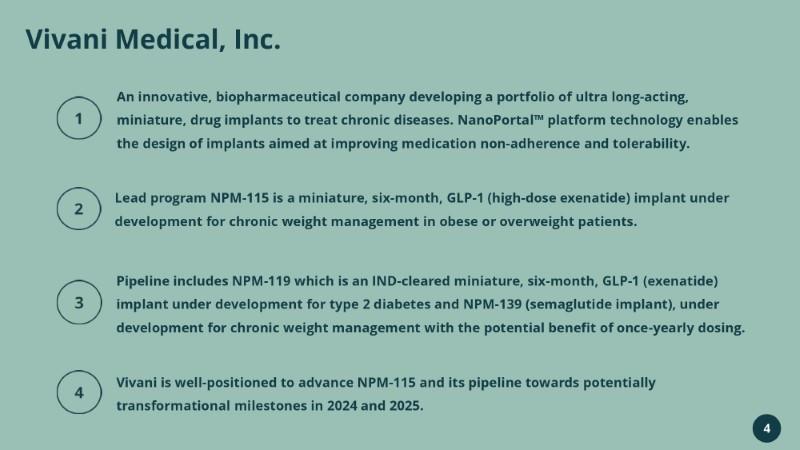
Vivani Medical, Inc. An innovative, biopharmaceutical company developing a portfolio of ultra long-acting, miniature, drug implants to treat chronic diseases. NanoPortal™ platform technology enables the design of implants aimed at improving medication non-adherence and tolerability.Lead program NPM-115 is a miniature, six-month, GLP-1 (high-dose exenatide) implant under development for chronic weight management in obese or overweight patients. Pipeline includes NPM-119 which is an IND-cleared miniature, six-month, GLP-1 (exenatide) implant under development for type 2 diabetes and NPM-139 (semaglutide implant), under development for chronic weight management with the potential benefit of once-yearly dosing.Vivani is well-positioned to advance NPM-115 and its pipeline towards potentially transformational milestones in 2024 and 2025.
.
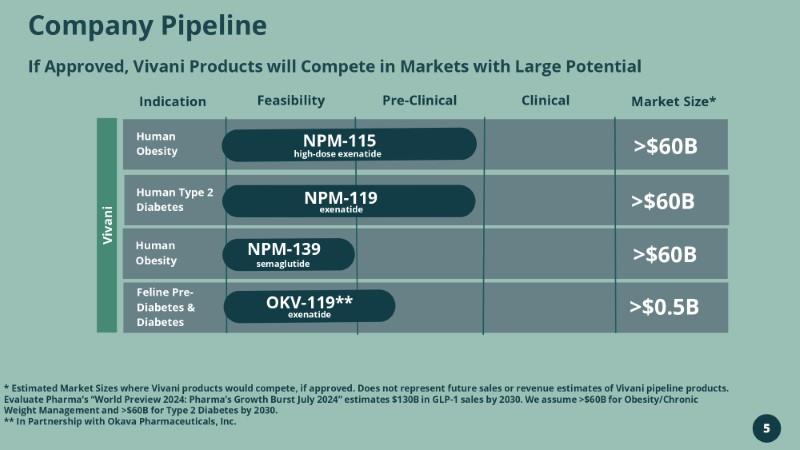
Company Pipeline If Approved, Vivani Products will Compete in Markets with Large Potential Indication Feasibility Pre-Clinical Clinical Market Size* Human Obesity NPM-115 high-dose exenatide >$60B Human Type 2 Diabetes NPM-119 exenatide >$60B Human Obesity NPM-139 semaglutide >$60B Feline Pre- Diabetes & Diabetes OKV-119** exenatide >$0.5B Estimated Market Sizes where Vivani products would compete, if approved. Does not represent future sales or revenue estimates of Vivani pipeline products. Evaluate Pharma’s “World Preview 2024: Pharma’s Growth Burst July 2024” estimates $130B in GLP-1 sales by 2030. We assume >$60B for Obesity/Chronic Weight Management and >$60B for Type 2 Diabetes by 2030. ** In Partnership with Okava Pharmaceuticals, Inc.
.
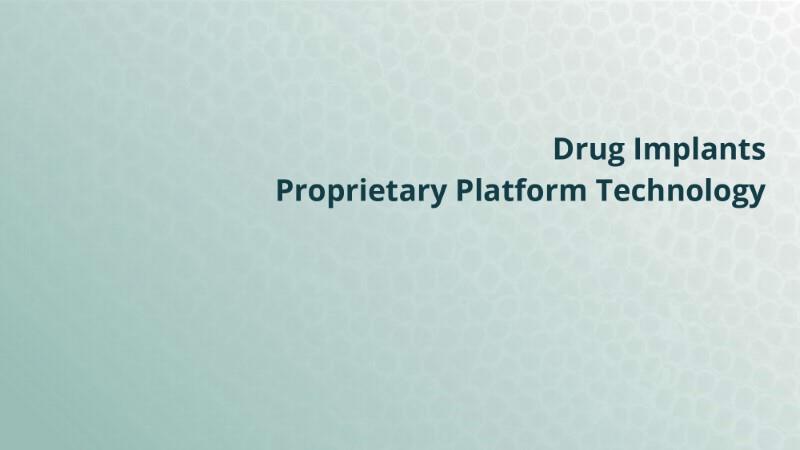
Drug Implants Proprietary Platform Technology
.
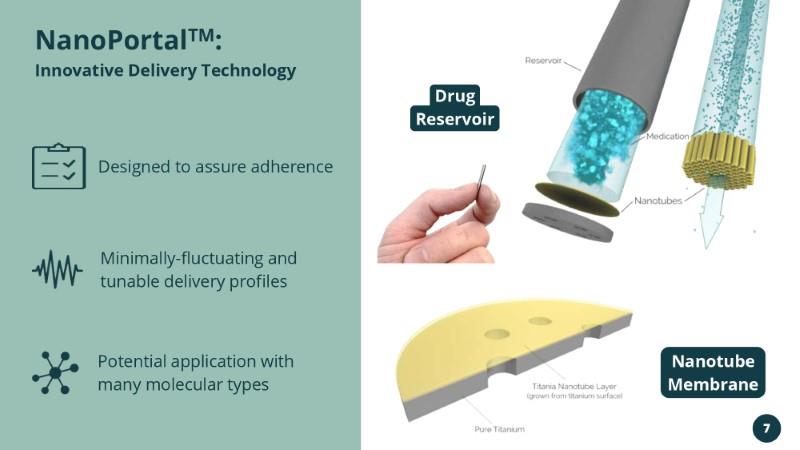
NanoPortalTM: Innovative Delivery Technology Designed to assure adherence Minimally-fluctuating and tunable delivery profiles Potential application with many molecular types Drug Reservoir Nanotube Membrane
.
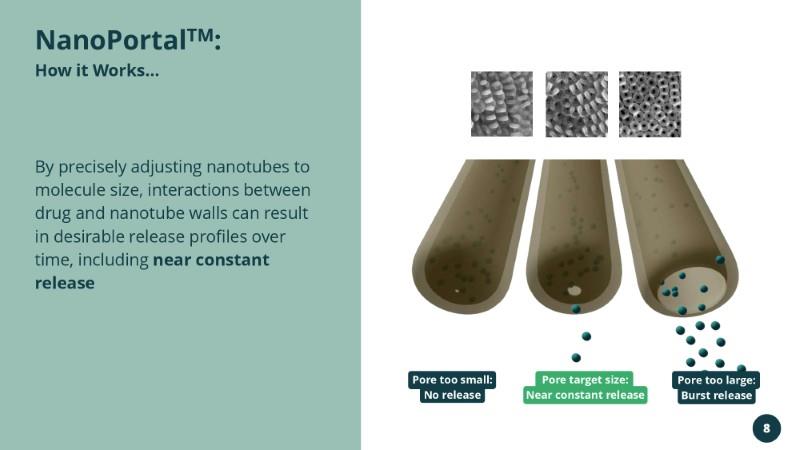
NanoPortalTM: How it Works... By precisely adjusting nanotubes to molecule size, interactions between drug and nanotube walls can result in desirable release profiles over time, including near constant release Pore too small: No release Pore target size: Near constant release Pore too large: Burst release
.

Near-constant and minimally-fluctuating release Day 1 timepoint includes cumulative release over the first day including a separately measured 1st hour of release, which was ~7 µg for the high-dose and ~4 µg for the low-dose. Values are mean ± SD. *Release-rates include exenatide and related substances. Minimal Fluctuations with 2.5-hour interval sampling Individual Release Profiles (n=6) Fluctuations during each 2.5-hour interval are within measurement error
.
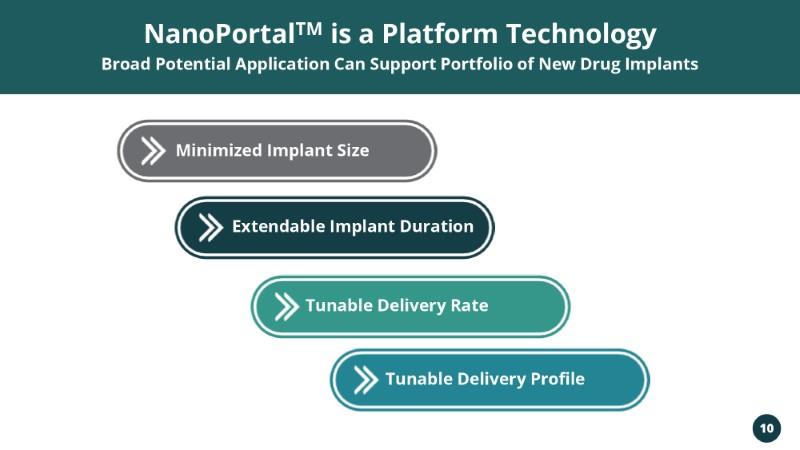
NanoPortalTM is a Platform Technology Broad Potential Application Can Support Portfolio of New Drug Implants Minimized Implant Size Extendable Implant Duration Tunable Delivery Rate Tunable Delivery Profile
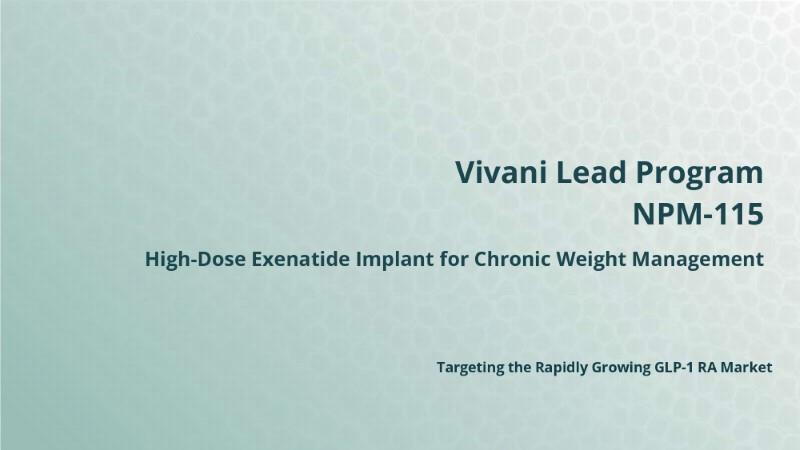
Vivani Lead Program NPM-115 High-Dose Exenatide Implant for Chronic Weight Management Targeting the Rapidly Growing GLP-1 RA Market
.

Lead Product NPM-115: 6-Month Exenatide (Glucagon-like Peptide 1 Receptor Agonist) Implant for Chronic Weight Management in Obese or Overweight Patients Tremendous unmet medical need in Obesity1: 764M people living with obesity 15M (2%) taking an anti-obesity medication GLP-1 monotherapy may provide adequate weight loss for the majority of patients2 Preclinical data with NPM-115 has demonstrated similar magnitude of weight loss for exenatide and semaglutide NPM-115 target profile may provide an attractive alternative to life-long injections or pills for long-term maintenance of GLP-1 therapy for weight management
.
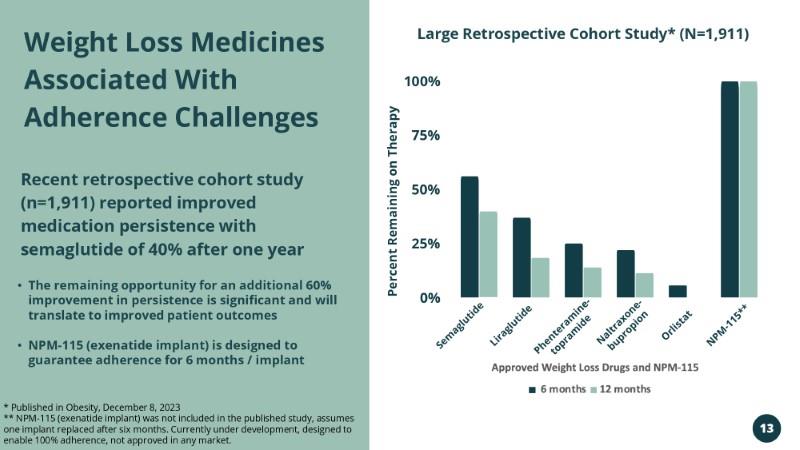
Weight Loss Medicines Associated With Adherence Challenges Recent retrospective cohort study (n=1,911) reported improved medication persistence with semaglutide of 40% after one year The remaining opportunity for an additional 60% improvement in persistence is significant and will translate to improved patient outcomes NPM-115 (exenatide implant) is designed to guarantee adherence for 6 months / implant * Published in Obesity, December 8, 2023 ** NPM-115 (exenatide implant) was not included in the published study, assumes one implant replaced after six months. Currently under development, designed to enable 100% adherence, not approved in any market. Large Retrospective Cohort Study* (N=1,911) Percent Remaining on Therapy 100% 75% 50% 25% 0% Semaglutide Liraglutide Phenteramine-topramide Naltraxone-bupropion Orlistat NPM-115**
.
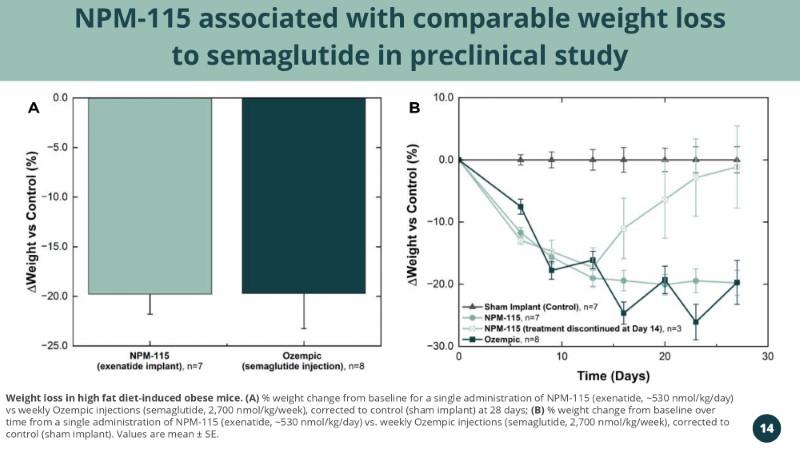
NPM-115 associated with comparable weight loss to semaglutide in preclinical study Weight loss in high fat diet-induced obese mice. (A) % weight change from baseline for a single administration of NPM-115 (exenatide, ~530 nmol/kg/day) vs weekly Ozempic injections (semaglutide, 2,700 nmol/kg/week), corrected to control (sham implant) at 28 days; (B) % weight change from baseline over time from a single administration of NPM-115 (exenatide, ~530 nmol/kg/day) vs. weekly Ozempic injections (semaglutide, 2,700 nmol/kg/week), corrected to control (sham implant). Values are mean ± SE.
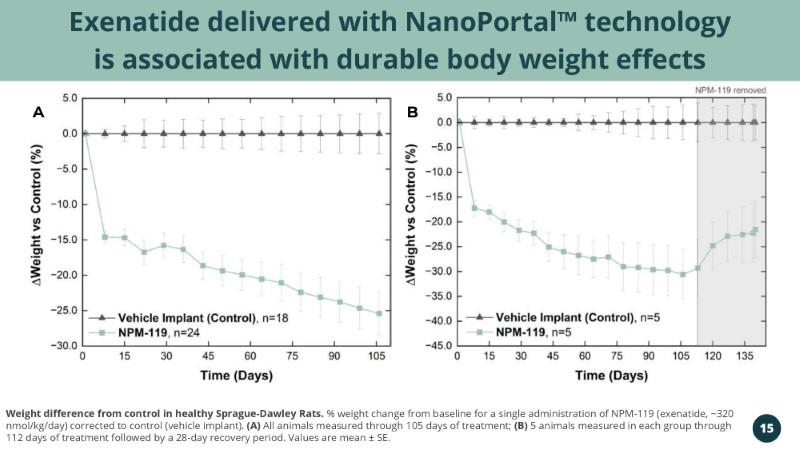
Exenatide delivered with NanoPortal™ technology is associated with durable body weight effects Weight difference from control in healthy Sprague-Dawley Rats. % weight change from baseline for a single administration of NPM-119 (exenatide, ~320 nmol/kg/day) corrected to control (vehicle implant). (A) All animals measured through 105 days of treatment; (B) 5 animals measured in each group through 112 days of treatment followed by a 28-day recovery period. Values are mean ± SE.
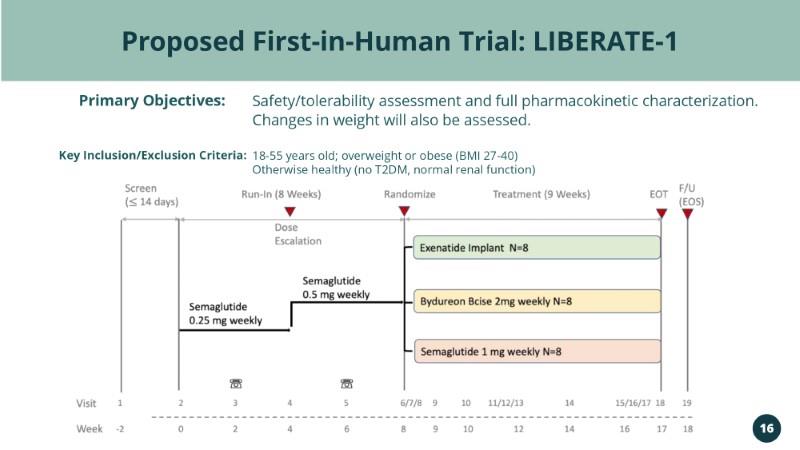
Proposed First-in-Human Trial: LIBERATE-1 Primary Objectives: Safety/tolerability assessment and full pharmacokinetic characterization. Changes in weight will also be assessed. Key Inclusion/Exclusion Criteria: 18-55 years old; overweight or obese (BMI 27-40) Otherwise healthy (no T2DM, normal renal function)
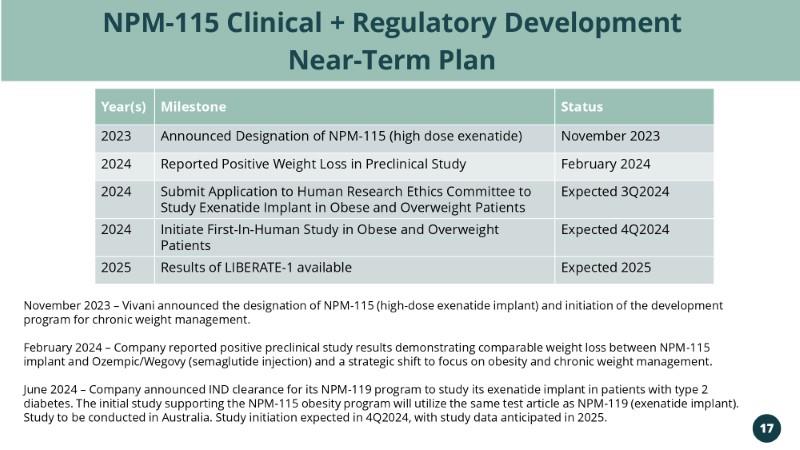
NPM-115 Clinical + Regulatory Development Near-Term Plan Year(s) Milestone Status 2023 Announced Designation of NPM-115 (high dose exenatide) November 2023 2024 Reported Positive Weight Loss in Preclinical Study February 2024 2024 Submit Application to Human Research Ethics Committee to Study Exenatide Implant in Obese and Overweight Patients Expected 3Q2024 2024 Initiate First-In-Human Study in Obese and Overweight Patients Expected 4Q2024 2025 Results of LIBERATE-1 available Expected 2025 November 2023 – Vivani announced the designation of NPM-115 (high-dose exenatide implant) and initiation of the development program for chronic weight management. February 2024 – Company reported positive preclinical study results demonstrating comparable weight loss between NPM-115 implant and Ozempic/Wegovy (semaglutide injection) and a strategic shift to focus on obesity and chronic weight management. June 2024 – Company announced IND clearance for its NPM-119 program to study its exenatide implant in patients with type 2 diabetes. The initial study supporting the NPM-115 obesity program will utilize the same test article as NPM-119 (exenatide implant). Study to be conducted in Australia. Study initiation expected in 4Q2024, with study data anticipated in 2025.

NPM-119 Exenatide Implant for Type 2 Diabetes Targeting the Rapidly Growing GLP-1 RA Market
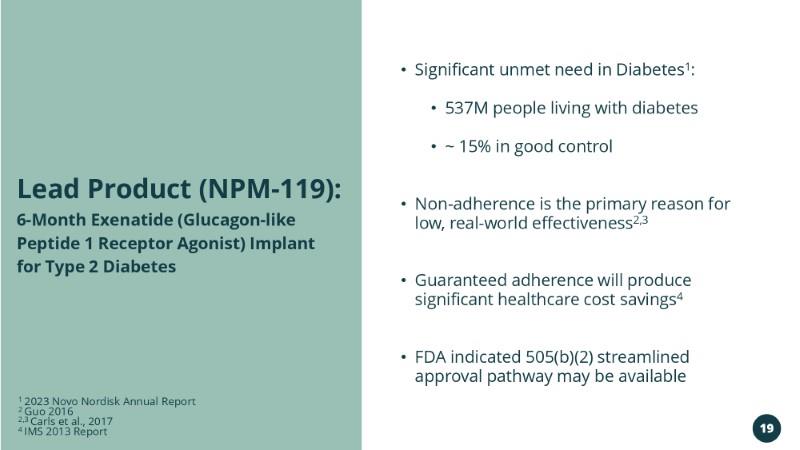
NPM-119 Exenatide Implant for Type 2 Diabetes Targeting the Rapidly Growing GLP-1 RA Market Lead Product (NPM-119): 6-Month Exenatide (Glucagon-like Peptide 1 Receptor Agonist) Implant for Type 2 Diabetes 1 2023 Novo Nordisk Annual Report 2 Guo 2016 2, 3 Carls et al., 2017 4 IMS 2013 Report Significant unmet need in Diabetes1: 537M people living with diabetes ~ 15% in good control Non-adherence is the primary reason for low, real-world effectiveness2,3 Guaranteed adherence will produce significant healthcare cost savings4 FDA indicated 505(b)(2) streamlined approval pathway may be available
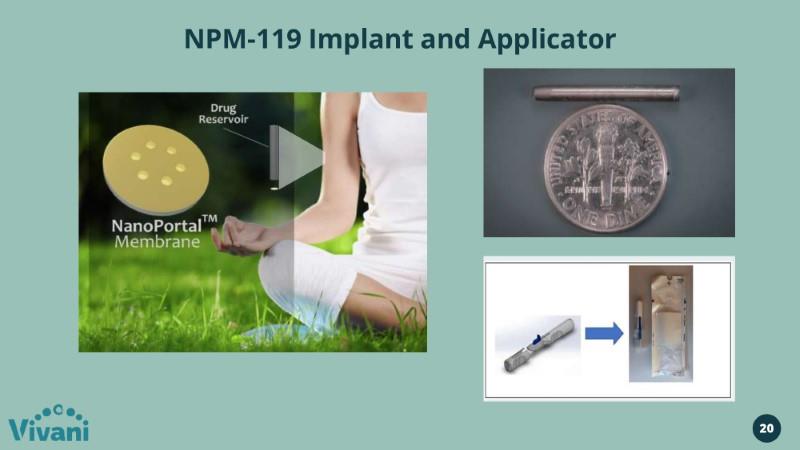
NPM-119 Implant and Applicator
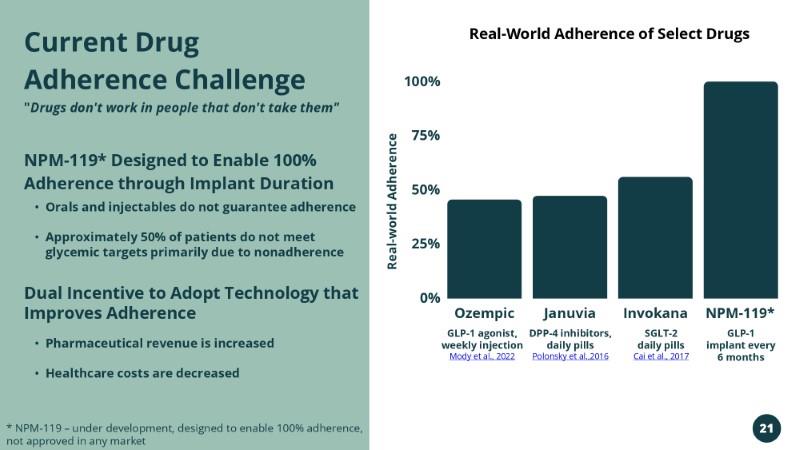
Current Drug Adherence Challenge "Drugs don't work in people that don't take them" NPM-119* Designed to Enable 100% Adherence through Implant Duration Orals and injectables do not guarantee adherence Approximately 50% of patients do not meet glycemic targets primarily due to nonadherence Dual Incentive to Adopt Technology that Improves Adherence Pharmaceutical revenue is increased Healthcare costs are decreased * NPM-119 – under development, designed to enable 100% adherence, not approved in any market Real-World Adherence of Select Drugs Real-world Adherence 100% 75% 50% 25% 0% Ozempic Januvia Invokana NPM-119* GLP-1 agonist, weekly injection Mody et al., 2022 DPP-4 inhibitors, daily pills Polonsky et al.,2016 SGLT-2 daily pills Cai et al., 2017 GLP-1 implant every 6 months
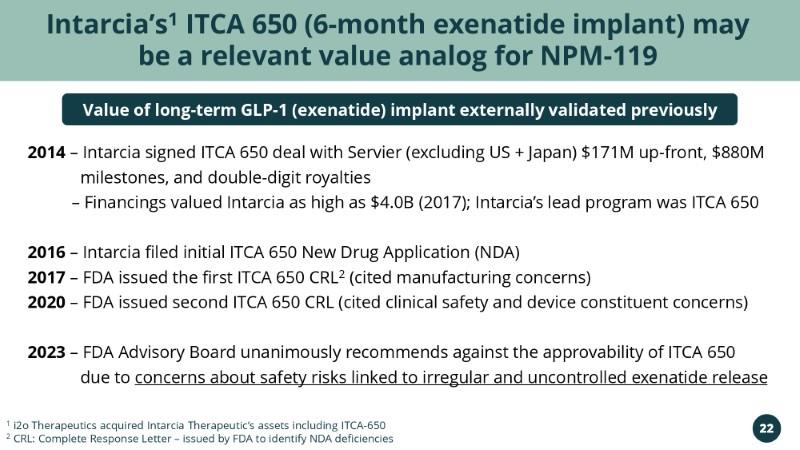
Intarcia’s1 ITCA 650 (6-month exenatide implant) may be a relevant value analog for NPM-119 Value of long-term GLP-1 (exenatide) implant externally validated previously 2014 – Intarcia signed ITCA 650 deal with Servier (excluding US + Japan) $171M up-front, $880M milestones, and double-digit royalties – Financings valued Intarcia as high as $4.0B (2017); Intarcia’s lead program was ITCA 650 2016 – Intarcia filed initial ITCA 650 New Drug Application (NDA) 2017 – FDA issued the first ITCA 650 CRL2 (cited manufacturing concerns) 2020 – FDA issued second ITCA 650 CRL (cited clinical safety and device constituent concerns) 2023 – FDA Advisory Board unanimously recommends against the approvability of ITCA 650 due to concerns about safety risks linked to irregular and uncontrolled exenatide release 1 i2o Therapeutics acquired Intarcia Therapeutic’s assets including ITCA-650 2 CRL: Complete Response Letter – issued by FDA to identify NDA deficiencies
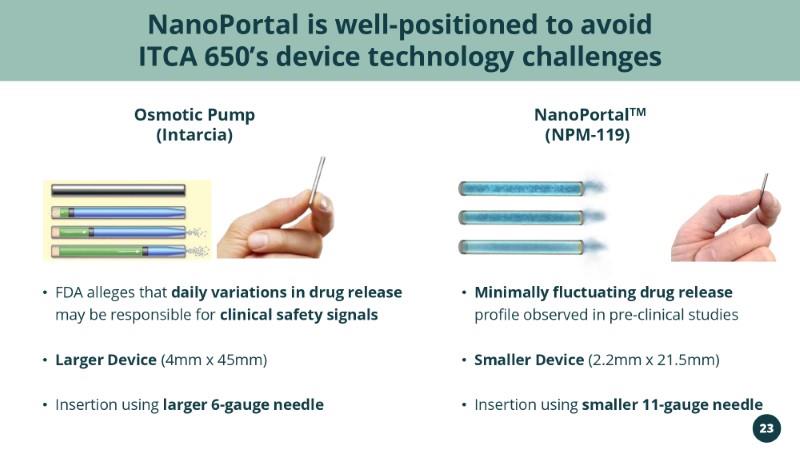
NanoPortal is well-positioned to avoid ITCA 650’s device technology challenges Osmotic Pump (Intarcia) NanoPortalTM (NPM-119) FDA alleges that daily variations in drug release may be responsible for clinical safety signals Larger Device (4mm x 45mm) Insertion using larger 6-gauge needle Minimally fluctuating drug release profile observed in pre-clinical studies Smaller Device (2.2mm x 21.5mm) Insertion using smaller 11-gauge needle
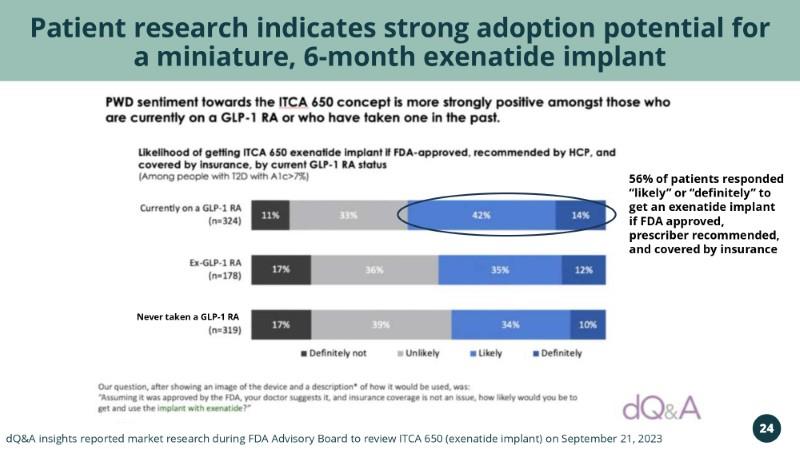
Patient research indicates strong adoption potential for a miniature, 6-month exenatide implant 56% of patients responded “likely” or “definitely” to get an exenatide implant if FDA approved, prescriber recommended, and covered by insurance dQ&A insights reported market research during FDA Advisory Board to review ITCA 650 (exenatide implant) on September 21, 2023
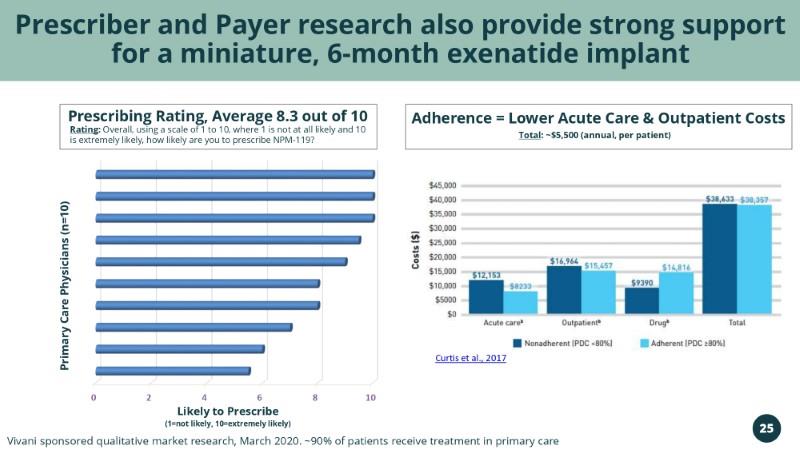
Prescriber and Payer research also provide strong support for a miniature, 6-month exenatide implant Prescribing Rating, Average 8.3 out of 10 Rating: Overall, using a scale of 1 to 10, where 1 is not at all likely and 10 is extremely likely, how likely are you to prescribe NPM-119? Adherence = Lower Acute Care & Outpatient Costs Total: ~$5,500 (annual, per patient) Primary Care Physicians (n=10) Likely to Prescribe (1=not likely, 10=extremely likely) Curtis et al., 2017 Vivani sponsored qualitative market research, March 2020. ~90% of patients receive treatment in primary care
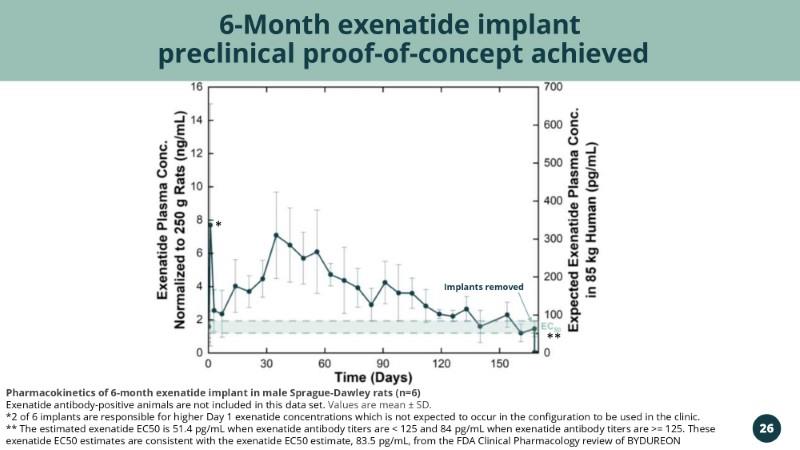
6-Month exenatide implant preclinical proof-of-concept achieved Pharmacokinetics of 6-month exenatide implant in male Sprague-Dawley rats (n=6) Exenatide antibody-positive animals are not included in this data set. Values are mean ± SD. *2 of 6 implants are responsible for higher Day 1 exenatide concentrations which is not expected to occur in the configuration to be used in the clinic. ** The estimated exenatide EC50 is 51.4 pg/mL when exenatide antibody titers are < 125 and 84 pg/mL when exenatide antibody titers are >= 125. These exenatide EC50 estimates are consistent with the exenatide EC50 estimate, 83.5 pg/mL, from the FDA Clinical Pharmacology review of BYDUREON
NPM-119 Clinical + Regulatory Development Near-Term Plan Year(s) Milestone Status 2024 Clinical Hold Lifted; IND cleared June 2024 June 13, 2024 – Vivani announced that the FDA lifted the clinical hold, clearing the NPM-119 IND to enable the evaluation of its exenatide implant in patients with type 2 diabetes. July 11, 2024 – Vivani reiterated its strategic shift to focus on the obesity applications of its implant technology and expressed its intention for the First In Human study to be in obese and overweight patients as part of the NPM-115 program. Vivani intends to evaluate its exenatide implant in patients with type 2 diabetes as part of its overall clinical strategy but will begin with obese and overweight patients as part of its NPM-115 program.
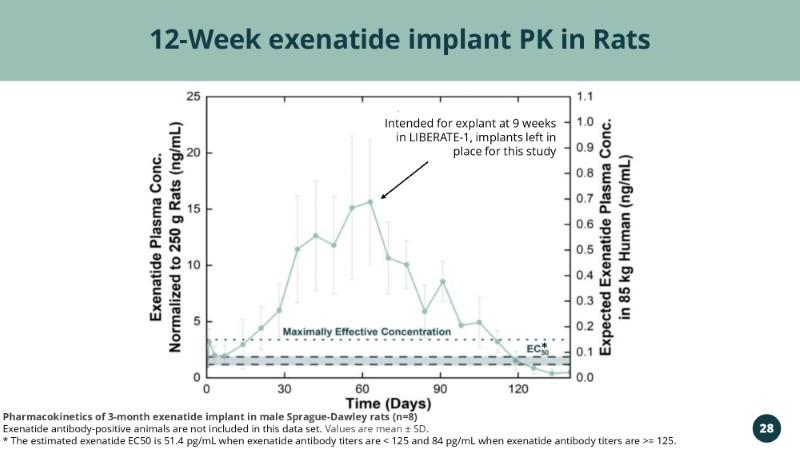
12-Week exenatide implant PK in Rats Pharmacokinetics of 3-month exenatide implant in male Sprague-Dawley rats (n=8) Exenatide antibody-positive animals are not included in this data set. Values are mean ± SD. * The estimated exenatide EC50 is 51.4 pg/mL when exenatide antibody titers are < 125 and 84 pg/mL when exenatide antibody titers are >= 125.

Vivani Medical, Inc. Financial Information
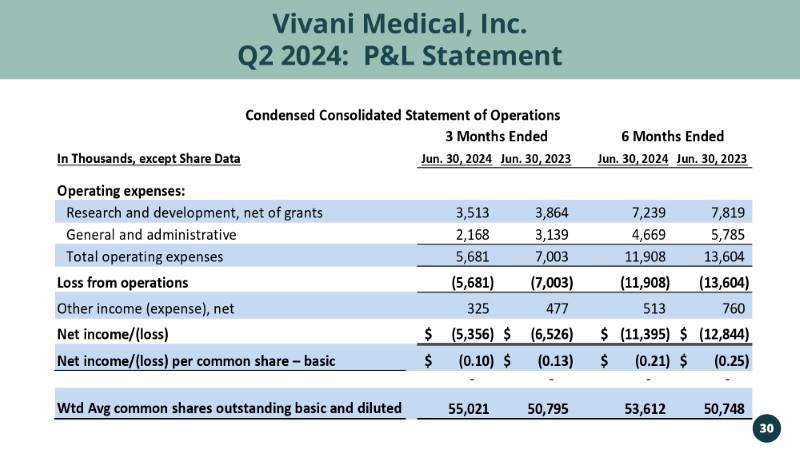
Vivani Medical, Inc. Q2 2024: P&L Statement In Thousands, except Share Data Jun. 30, 2024 Jun. 30, 2023 Jun. 30, 2024 Jun. 30, 2023 Condensed Consolidated Statement of Operations 3 Months Ended 6 Months Ended Operating expenses: Research and development, net of grants 3,513 3,864 7,239 7,819 General and administrative 2,168 3,139 4,669 5,785 Total operating expenses 5,681 7,003 11,908 13,604 Loss from operations (5,681) (7,003) (11,908) (13,604) Other income (expense), net 325 477 513 760 Net income/(loss) $ (5,356) $ (6,526) $ (11,395) $ (12,844) Net income/(loss) per common share – basic $ (0.10) $ (0.13) $ (0.21) $ (0.25) - - - - Wtd Avg common shares outstanding basic and diluted 55,021 50,795 53,612 50,748
Vivani Medical, Inc. Q2 2024: Balance Sheet Condensed Consolidated Balance Sheets (unaudited) In Thousands Jun. 30, 2024 Dec. 31, 2023 ASSETS Current assets: Cash and cash equivalents $ 24,919 $ 20,654 Prepaid expenses and other current assets 1,418 2,408 Total current assets 26,337 23,062 Property and equipment, net 1,710 1,729 Right-of-use assets 18,801 19,616 Restricted cash 1,338 1,338 Deposits and other assets 38 52 Total assets $ 48,224 $ 45,797 LIABILITIE S AND STOCKHOLDERS’ EQUITY Current liabilities $ 5,784 $ 5,72 Long term operating lease liabilities 18,616 19,313 Total liabilities 24,400 25,036 Stockholders’ equity: - - Total Common Stock, APIC & Other Comp Gain 133,657 119,199 Accumulated deficit (109,833) (98,438) Total liabilities and stockholders’ equity $ 48,224 $ 45,797

Vivani Medical, Inc. Q2 2024: Cap Table As of June 30, 2024 Equity Common Stock Stock Options RSUs Warrants Fully Diluted Shares WAEP* $2.55 - $3.39 Number of Shares 55,196,703 6,615,656 695,000 10,484,342 70,137,371 *Weighted Average Exercise Price

Vivani Medical, Inc. An innovative, biopharmaceutical company developing a portfolio of ultra long-acting, miniature, drug implants to treat chronic diseases. NanoPortal™ platform technology enables the design of implants aimed at improving medication non-adherence and tolerability. Lead program NPM-115 is a miniature, six-month, GLP-1 (high-dose exenatide) implant under development for chronic weight management in obese or overweight patients. Pipeline includes NPM-119 which is an IND-cleared miniature, six-month, GLP-1 (exenatide) implant under development for type 2 diabetes and NPM-139 (semaglutide implant), under development for chronic weight management with the potential benefit of once-yearly dosing Vivani is well-positioned to advance NPM-115 and its pipeline towards potentially transformational milestones in 2024 and 2025.
